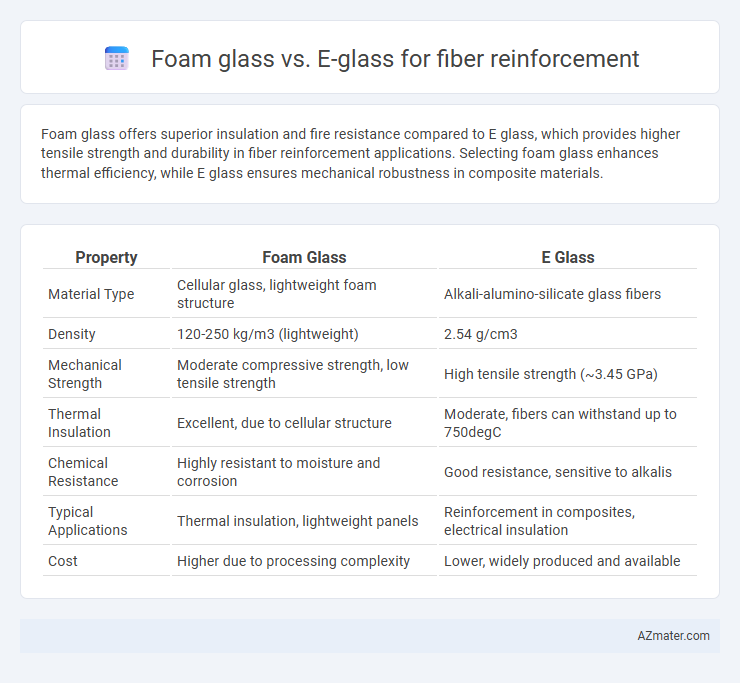Foam glass offers superior insulation and fire resistance compared to E glass, which provides higher tensile strength and durability in fiber reinforcement applications. Selecting foam glass enhances thermal efficiency, while E glass ensures mechanical robustness in composite materials.
Table of Comparison
| Property | Foam Glass | E Glass |
|---|---|---|
| Material Type | Cellular glass, lightweight foam structure | Alkali-alumino-silicate glass fibers |
| Density | 120-250 kg/m3 (lightweight) | 2.54 g/cm3 |
| Mechanical Strength | Moderate compressive strength, low tensile strength | High tensile strength (~3.45 GPa) |
| Thermal Insulation | Excellent, due to cellular structure | Moderate, fibers can withstand up to 750degC |
| Chemical Resistance | Highly resistant to moisture and corrosion | Good resistance, sensitive to alkalis |
| Typical Applications | Thermal insulation, lightweight panels | Reinforcement in composites, electrical insulation |
| Cost | Higher due to processing complexity | Lower, widely produced and available |
Introduction to Fiber Reinforcement Materials
Foam glass and E glass are commonly used fiber reinforcement materials with distinct properties influencing their application performance. Foam glass offers excellent thermal insulation, lightweight structure, and chemical resistance, making it ideal for specialized composite applications requiring durability and thermal stability. E glass, an electrical grade fiberglass, provides high tensile strength, good dielectric qualities, and cost-effectiveness, broadly utilized in structural composites and electrical insulation.
What is Foam Glass?
Foam glass is a lightweight, porous material made from crushed glass that is heated until it forms a cellular structure with high compressive strength and excellent thermal insulation properties. Unlike E glass fibers, which are continuous silica-based fibers used primarily for reinforcing composites, foam glass serves as a lightweight aggregate or structural filler that enhances fire resistance and durability in fiber-reinforced materials. Its closed-cell structure also provides superior moisture resistance, making it ideal for insulation and reinforcement in construction and industrial applications.
Understanding E Glass: Composition and Properties
E Glass fiber is composed primarily of alumino-borosilicate with around 54-56% silicon dioxide (SiO2), 12-16% aluminum oxide (Al2O3), and smaller amounts of calcium oxide and magnesium oxide, providing excellent electrical insulation and mechanical strength. Its lightweight nature, high tensile strength, and resistance to moisture and chemicals make it ideal for reinforcing composites in aerospace, automotive, and construction applications. Compared to foam glass, which is a rigid cellular glass material mainly used for insulation, E Glass serves a distinct role in enhancing structural integrity and durability in fiber-reinforced polymers.
Mechanical Strength: Foam Glass vs E Glass
Foam glass exhibits lower mechanical strength compared to E glass fibers, which are known for their high tensile strength and excellent stiffness, making them ideal for fiber reinforcement applications. E glass fibers typically provide tensile strengths around 2.5 to 3.5 GPa, whereas foam glass is more brittle and less capable of withstanding high tensile and flexural stresses. The superior mechanical performance of E glass ensures enhanced durability and load-bearing capacity in composite materials relative to foam glass.
Thermal Insulation Capabilities Compared
Foam glass offers superior thermal insulation capabilities compared to E glass fiber due to its closed-cell structure that effectively traps air and minimizes heat transfer. E glass fiber, while strong and widely used in composites, is less efficient as a thermal insulator because of its higher thermal conductivity. The inherent low thermal conductivity of foam glass makes it ideal for applications requiring enhanced heat resistance and energy efficiency.
Chemical Resistance and Durability
Foam glass exhibits exceptional chemical resistance due to its inert glass structure, making it highly durable against acids, alkalis, and solvents compared to E glass fiber, which can degrade under harsh chemical environments. E glass fibers offer good mechanical strength but are more susceptible to chemical attack and moisture absorption, reducing their long-term durability in corrosive conditions. Foam glass's closed-cell structure enhances its resistance to chemical infiltration and physical wear, providing superior longevity in demanding reinforcement applications.
Weight and Density Considerations
Foam glass exhibits significantly lower density, typically around 0.25 to 0.35 g/cm3, compared to E glass fibers which range from 2.5 to 2.6 g/cm3, making foam glass a superior choice for weight-sensitive applications. The lightweight nature of foam glass enhances structural efficiency by reducing overall component mass without compromising insulation properties. E glass, despite its higher density, offers excellent mechanical strength and durability, suitable for reinforcement requiring higher load-bearing capacity.
Applications in Construction and Industry
Foam glass excels in construction as an insulating and lightweight aggregate, enhancing thermal insulation and fire resistance in building panels and lightweight concrete, while providing chemical stability and compressive strength. E glass fibers are widely used in industrial composite materials, offering high tensile strength, electrical insulation, and durability, making them ideal for reinforcing concrete, wind turbine blades, and automotive components. Both materials support sustainability goals, with foam glass promoting energy efficiency in buildings, and E glass enabling lightweight, high-performance structural components.
Environmental Impact and Sustainability
Foam glass exhibits superior environmental impact due to its recyclability, low embodied energy, and ability to reduce waste by incorporating recycled glass, making it a sustainable choice for fiber reinforcement. E glass, while widely used for its strength and affordability, involves energy-intensive production processes and generates non-biodegradable waste, raising concerns about long-term sustainability. Incorporating foam glass fibers can significantly lower the carbon footprint of composite materials while enhancing fire resistance and thermal insulation properties.
Cost Analysis and Market Availability
Foam glass offers a higher price point compared to E glass due to its specialized manufacturing process and niche applications, making it less cost-effective for large-scale fiber reinforcement. E glass remains the market leader with widespread availability, competitive pricing, and extensive supplier networks globally, ensuring cost efficiency. The market availability of E glass fibers is significantly higher, supported by established production infrastructure and demand across industries like automotive and construction.

Infographic: Foam glass vs E glass for Fiber reinforcement
 azmater.com
azmater.com